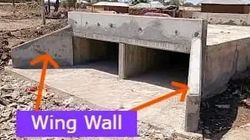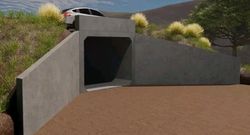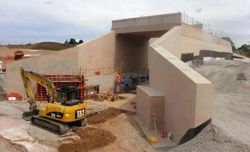Oct 20, 2024
Wing Wall Stabillity




Wingwall stability?
A wing wall is typically a retaining structure that extends from a bridge abutment or culvert to retain earth and provide lateral support. The design of a wing wall, particularly in terms of stability, requires careful consideration of both structural and geotechnical factors. Here's a step-by-step guide on how wing wall stability is addressed during design:
1. Determine Loads and Forces
Earth Pressure: Calculate the lateral earth pressure based on the soil type, wall height, and backfill slope. Earth pressure theories like Rankine or Coulomb can be used to estimate active or passive earth pressure.
Surcharge Loads: Account for any additional loads (like traffic, buildings, etc.) that may exert lateral pressure on the wall.
Water Pressure: If the wall is retaining soil that could become saturated, account for hydrostatic pressure.
Live and Dead Loads: Include dead load (weight of the wall and soil) and any live load due to vehicle traffic, if applicable.
2. Check Stability Against Failure Modes
Overturning: Ensure that the wall does not rotate about its toe. This is achieved by designing the wall such that the resisting moment (due to the weight of the wall and any passive earth pressure) exceeds the overturning moment (due to lateral earth pressure and other forces).
Factor of safety against overturning should typically be greater than 1.5.
Sliding: Ensure the wall does not slide horizontally due to lateral earth pressure. The frictional resistance at the base and any passive resistance at the front of the wall help resist sliding.
Factor of safety against sliding should be greater than 1.5.
Bearing Capacity Failure: Ensure that the pressure exerted at the base of the wall does not exceed the soil's bearing capacity. Check using bearing capacity equations (e.g., Terzaghi’s or Meyerhof’s).
Factor of safety against bearing failure should be greater than 3.
Settlement: Ensure that the foundation of the wing wall will not settle excessively, leading to structural problems. Settlement calculations are typically done based on soil properties.
3. Structural Design of the Wing Wall
Reinforced Concrete Design: The wing wall is often constructed from reinforced concrete. The structural design should consider:
Bending moments and shear forces from lateral earth pressure.
Proper reinforcement layout to resist tensile stresses and shear.
Thickness: The thickness of the wall should be sufficient to resist bending and shear stresses. It should also be thick enough to provide stability in the form of dead load.
Base Design: The base slab (or footing) should be designed to resist moments and shear forces and to provide stability against sliding and overturning.
4. Drainage Considerations
Drainage is crucial to ensure that hydrostatic pressure does not build up behind the wing wall. Common solutions include weep holes or a drainage layer behind the wall.
Proper drainage reduces the risk of water pressure contributing to instability.
5. Material Selection
Select durable materials that can withstand environmental exposure, such as reinforced concrete designed to handle freeze-thaw cycles, and possibly water-resistant treatments.
6. Geotechnical Considerations
Soil conditions (cohesion, angle of internal friction, and unit weight) are key inputs for earth pressure calculations.
Subsurface investigations (such as boreholes) should be conducted to assess the soil profile and ensure proper foundation design.
7. Seismic Design (If Applicable)
In seismic regions, additional lateral forces due to earthquake activity should be considered in the design. This typically involves applying seismic coefficients to the earth pressures and designing for increased lateral forces and potential dynamic effects.
8. Safety Factors
Apply appropriate safety factors to account for uncertainties in load estimates, material strengths, and soil conditions. Safety factors are typically applied to sliding, overturning, and bearing capacity analyses.
9. Construction and Detailing
Ensure good construction practices to prevent issues like poor compaction, inadequate drainage, or weak concrete, which could affect long-term stability.
Proper detailing for reinforcement placement and concrete pouring is essential to ensure the structural integrity of the wall.
This is a general outline. The exact design process depends on specific project conditions, including local codes and standards.
By undefined
5 notes ・ 0 views
English
Intermediate